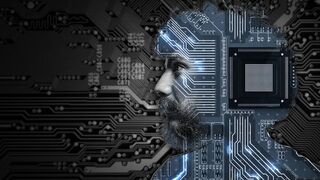Thought as Currency
Cryptocurrency may give way to neurocurrency.
KEY POINTS
- Technology has afforded us the opportunity to translate thought into digital form.
- Extracting thoughts and rendering them digitally may stop ideas from getting “lost in translation” when humans try to physically manifest them.
- Once pure ideas are extracted and digitally preserved, they could be valued and monetized into “neurocurrency.”

The emergence of cryptocurrency is changing the world. In some instances, it’s a practical and logical extension of monetary or commerce systems. In other instances, it’s a bit more abstract such as the non-fungible token (NFT), where intellectual property becomes “coined” into a digital asset that lives on the blockchain.
The magic, in this case, is in the technology. But the “creative process” is no different than prehistoric cave paintings. An idea is conjured and then transferred from thought to material reality. And it’s only after the conversion is complete that the idea takes a functional existence—from a cave drawing to a modern architectural rendering. That’s where value can enter the system of exchange or commerce. Yet conversely, the transfer of the core idea to paper can often be the point where the idea fails to translate effectively or into a form that effectively captures this idea. Tragically, the idea becomes “lost in translation.”
Thoughts Require Materialization
In today’s technological world and the emerging science of “neuro-connectivity,” we may be able to rethink the process of thinking and the necessity of physical manifestations of those thoughts.
A thought takes on a tangible presence when it is translated into words, sounds, art, and other physical objects. It’s a multi-step process that changes thoughts into a form of human currency that can be transferred in a variety of contexts. My art, my design, or my poetry come into existence only when translated from thoughts to the material form.
But what about that thought itself? What about the music that lives in your brain? What about the ideas and experiences that haven’t been codified into a “post personal” interpretation and shared with others? In many ways, there are as real as can be, yet equally ethereal.
Thoughts as Formless Ideas
Elon Musk has suggested the idea of streaming music directly into your brain. And the long-term utility of cochlear implants has established the viability of this general concept—an electronic brain interface.
But can we extract a thought—a thought quanta—from a brain and preserve it in a digital form? Can a collection of thoughts that establish a visual image in your brain be decoded and reproduced externally?
In a small way, the answer is yes! Today, scientists can actually generate recognizable images that have never existed in the “conventional world” but have only been imagined in the brain. These thoughts can live abstractly in the techno-ether and be preserved, transferred, and protected having never materialized in physical form.
article continues after advertisement
Pure Thoughts Translated to Real Currency
It’s only a matter of time before these “pure ideas” can become digitally preserved. Simply put, you can “think it” into existence and leverage technology to translate and store your cognitive workflow.
This preempts the tedious process of “getting an idea onto paper” that can often be labor-intensive and require specific artistic talents unavailable to the thinker. And the transference of thought into a digital form can facilitate today’s trendy and potentially lucrative concept tokenization, so your idea is “minted” into the decentralized blockchain as a permanent and immutable digital form. And this can directly impact marketplace-driven value for your pure idea.
Thought is humanity’s greatest asset. Thought leads to action and action becomes reality. And it’s this process that has given rise to the complexities of today’s financial system. Technology has afforded us the opportunity to capture thought in its nascent form. The path to monetization can’t be far behind.
